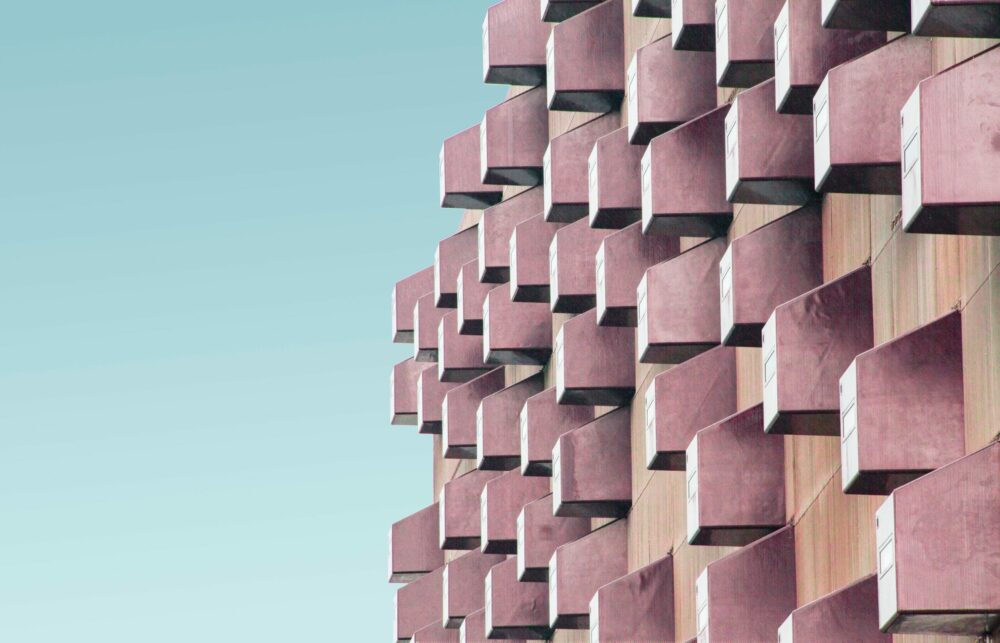Brutalist architecture is one of the most controversial styles of architecture to exist. It’s what people imagine when they think about what a prison looks like, with its cold and imposing exterior. Brutalism is also what people typically picture when they think of government buildings or schools built in the 1950s-1960s.
This article will explore Brutalist Architecture and how it became so popular. We’ve experienced our fair share while running our architecture summer schools in Cambridge, including the infamous Typewriter building.
Brutalist architecture is known for its heavy, imposing appearance. If there’s one word that can sum up the entirety of brutalism, it’s the word “concrete.” The style came in response to the sleek and polished Moderne style popular during the early 20th century.
It was French-Swiss Modernist architect Le Corbusier who began building brutalist structures. He began designing in such a manner in the 1950s, and they soon became popular worldwide. Other architects who helped popularise brutalist design include Alison and Peter Smithson, Marcel Breuer, and Ernő Goldfinger.
Le Corbusier (1187-1965)
French-Swiss architect and city planner Le Corbusier were one of the most influential architects of the 20th century and the leading proponent of brutalist architecture.
The heavy emphasis on functionalism, bold expressionism, sculptural form, and efficient spaces sets his architectural design apart. UNESCO named 17 of his architectural works World Heritage sites by 2016.
Alison Smithson (1928-1993) and Peter Smithson (1923-2003)
Together, Alison and Peter Smithson are the couple that “led British Brutalism” in the late 20th century. Alison was born in South Yorkshire, Peter, in North-East England.
The two met at Durham University and tied the knot in 1949. After graduating, they worked with London County Council’s Architecture Department, participating in urban planning.
Later they established their partnership in 1950. Their notable works include “The Economist” at Picadilly, London, and the Garden building at St. Hilda’s College.
If you’re interested in what the best-ranked UK universities for Architecture are then look no further!
Marcel Breuer (1902-1981)
Marcel Breuer was an American architect born in Hungary in 1902. He invented the “Wassily Chair” in 1925 – a tubular metal chair imitating the design of bicycle handlebars.
He’s one of the leading figures of brutalist architecture. His most famous works include the Whitney Museum of American Art in New York City and the UNESCO Headquarters in Paris.
Join the Immerse Education 2025 Essay Competition
Follow the instructions to write and submit your best essay for a chance to be awarded a 100% scholarship.

Ernő Goldfinger (1902-1987)
British architect Ernő Goldfinger is best known for his work on the Trellick Tower in London. He was born in Budapest, Hungary, in 1902 and later moved to the United Kingdom. Goldfinger is considered one of the prominent architects of Brutalist architecture. The Trellick Tower, completed in 1972, is a 31-story tower considered a Brutalist architecture landmark.
These architects wanted to create honest and straightforward buildings without any unnecessary ornamentation. They believed the buildings are best made from readily available materials, like concrete.
Due to their bare and honest appearance, they are considered “brutal.” More accurately, however, the word “brutalism” comes from the French word “béton brut”, which means “raw concrete.”
Where did the sentiment come from? Post world war. After World War 2, steel and other metals were in high demand, and concrete became a popular material to build with.
The Socialist Idea Behind Brutalist Architecture
Brutalist architecture, now known as part of “socialist architecture”, was inspired by the idea of the perfect society.
The architects who pioneered the Brutalist style believed their buildings could help create a better, more egalitarian world. Mainly because of the low cost and speedy construction associated with concrete. While not all Brutalist buildings were intended to be explicitly socialist, the style is often associated with this idealistic worldview.
While Brutalist architecture is not everyone’s cup of tea, it has been used in some famous dystopian movies. One of the most famous is George Orwell’s “1984”, which features the imposing Ministry of Truth, a massive Brutalist building made entirely from concrete.
Other examples include “Escape from New York” and “Batman Begins”, which feature Gotham City’s grim, imposing Brutalist buildings.
Famous Brutalist Buildings Around The World
While brutalist buildings are not popular with everyone, they are considered an important part of our architectural history. Some of the most famous Brutalist buildings around the world include:
Cité Radieuse, Marseille
The Cité Radieuse, or “Radiant City,” is a Brutalist building in Marseille, France, listed in the UNESCO World Heritage Site. It was architect Le Corbusier who designed and completed it in 1952.
The Cité Radieuse was initially built as a housing complex for the workers of the Renault automobile factory. It has over 337 apartments accommodating 1600 people, with shops for various businesses. Le Corbusier intended each apartment to be a “machine for living,” containing facilities to “free women” from doing chores.
Sirius Building, Sydney
The Sirius Building, located in Sydney, Australia, was designed by Tao Gofers in 1979. It was built as public housing for the local community members, containing 79 units, offering a stunning view of the Sydney Harbour Bridge and Opera House.
The people rallied in its defense in response to the government wanting to sell it to private real estate companies. They believe it should continue its role as public housing for the people. Also, the Heritage Council of New South Wales recommended listing the Sirius Building due to its cultural and architectural significance in February 2016.
The Breuer Building, New York City
The Breuer Building, located in New York City, is one of the first Brutalist buildings in the United States. Marcel Breuer designed the structure – which was completed in 1966. The building’s original intention was to serve as the Whitney Museum of American Art headquarters.
It looks like an inverted ziggurat with its heavy rectangular blocks stacked on top of each other. The Breuer Building is made of concrete and glass and has been praised for its excellent architectural qualities.
Trellick Tower, London
The Trellick Tower, located in London, England, is a 31-story, 98-meter residential tower block. It was the Greater London Council in 1966 that commissioned architect Ernő Goldfinger to design the building – which was completed in 1972. It’s one of the most famous examples of Brutalist architecture globally.
Containing 217 flats, the Greater London Council intended it for social housing. However, they transferred ownership of the building to the local council soon after its completion. Today, most flats are still used for housing public communities, although private owners own some.
Boston City Hall, Boston
Boston City Hall is one of the most iconic Brutalist buildings in the United States. It was designed by architect Kallmann McKinnell and Knowles and completed in 1968. The building’s imposing, heavy appearance made it famous during the Brutalist movement.
Boston City Hall is made of concrete and glass and contains a public plaza encompassing the entire building. Its design was heavily influenced by Le Corbusier’s “Sainte Marie de La Tourette.” The building has been met with mixed reactions over the years. While some praise its unique and interesting design, others find it unappealing and ugly, but that’s one of the beauties of studying architecture.
Paul Rudolph Hall, New Haven, Connecticut
Paul Rudolph Hall, located at Yale University in New Haven, Connecticut, is one of the oldest examples of Brutalist architecture in the United States. It was designed by architect Paul Rudolph and completed in 1963. Paul was the chair of the Yale School of Architecture at that time.
The Rudolph hall was assigned as the Art and Architecture building and is considered one of Paul’s most significant works. It won an Award of Honor from the American Institute of Architects.
Why Brutalist Architecture Declined In Popularity
Brutalist architecture began to decline in popularity in the 1970s and 1980s. This was due to several factors, including the high maintenance cost and the style often seen as ugly and oppressive.
Many people also felt that Brutalist buildings were not functional and lacked warmth and personality. In the 1990s, there was a resurgence of interest in Brutalist architecture, but it has never regained its former popularity.
While Brutalist buildings are still standing, they are no longer being built in the same numbers as during the 1950s-1960s. Today, most brutalist buildings belong to government and educational institutions.
But that’s not to say all architecture has declined, there’s been amazing growth in the top 8 career options for architects!
Wrapping Up
Now that you know brutalist architecture, what do you think of it? Many have mixed opinions, appreciating it for its historical place but also disliking its dark, soulless look.
Regardless, it’s a period we should all learn about and appreciate.




















